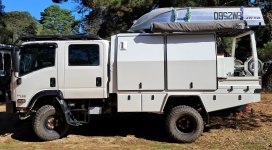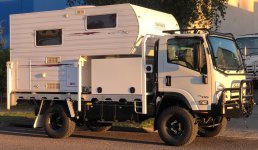Ultimark
Active member
Hmm, not too sure about that.I think it would turn the same as a 170ext MB sprinter
Our NPS has what Isuzu calls their medium wheelbase of 3395mm, it's turning circle is 13.6m. This is the only wheelbase available for the NPS in Australia, and probably the world.
The NPR comes in a few wheelbase lengths, however the crew cab version only comes in their LWB format, which is 4175mm, it's turning circle is 15.3m
Making a 4x2 vehicle into a 4x4 could possibly increase the turning circle somewhat as usually the angle of turn is reduced slightly to enable the drive line to live a long and fruitful life.
On the NPS front axle there is a bolt that can be adjusted to reduce the angle of turn, the idea being to further reduce the angle when fitting wider tyres. The NPS is also manufactured for the Japanese military and comes with super singles as standard, this adjustment bolt may be fitted for those OEM super single machines.
Below is an NPS 75/155 crew cab with the longest tray that can be legally fitted to an Australian NPS, (60% of the wheelbase overhang). They were about 80m from where I was earlier this year and are living in this fulltime towing a caravan, which can be just seen in the background.
He had one major complaint, the fuel tank of 140 litres was not big enough. We have two OEM tanks on the right side which gives us 280 litres. Any crew cab variant with two fuel tanks has one either side as the cabin isn't allowed to be over the fuel tanks.
Mick.




